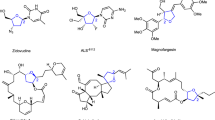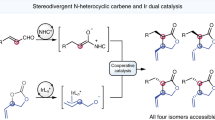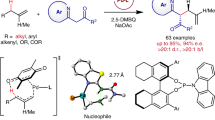Abstract
Metal-catalysed asymmetric allylic alkylation reactions have played a pivotal role in the construction of chiral compounds. When applied to the synthesis of butenolides, a common moiety present in many biologically active compounds, this reaction has always provided the C3-allylated products and only traces of the C5-allylated analogues. Here we report a Pd-catalysed C5-selective method that provides direct and highly enantioselective (up to >99% e.e.) access to a wide range of substituted butenolides using 2-substituted allyl acetates as the allylic partner. Mechanistic studies supported by density functional theory calculations have shown that the C5-selectivity observed is the result of a steric constraint induced by the substituent on the central carbon of the π–allyl complex forcing the reactive dienolate intermediate to expose its C5-reactive centre. The practicality, scalability and synthetic utility of the process was demonstrated through the total synthesis of three O-terpenoidal natural products: excavacoumarin B, D and E.

This is a preview of subscription content, access via your institution
Access options
Subscribe to this journal
Receive 12 digital issues and online access to articles
$119.00 per year
only $9.92 per issue
Buy this article
- Purchase on Springer Link
- Instant access to full article PDF
Prices may be subject to local taxes which are calculated during checkout



Similar content being viewed by others
Data availability
The experimental data as well as the characterization data for all the compounds prepared during this study, including NMR spectra and HPLC traces, are provided in the Supplementary Information. Crystallographic data for one of the structures reported in this Article have been deposited at the Cambridge Crystallographic Data Centre, under deposition no. CCDC 2102893 (7). Copies of the data can be obtained free of charge via https://www.ccdc.cam.ac.uk/structures/.
References
Pàmies, O. et al. Recent advances in enantioselective Pd-catalyzed allylic substitution: from design to applications. Chem. Rev. 121, 4373–4505 (2021).
Cheng, Q. et al. Iridium-catalyzed asymmetric allylic substitution reactions. Chem. Rev. 119, 1855–1969 (2019).
Süsse, L. & Stoltz, B. M. Enantioselective formation of quaternary centers by allylic alkylation with first-row transition-metal catalysts. Chem. Rev. 121, 4084–4099 (2021).
James, J., Jackson, M. & Guiry, P. J. Palladium-catalyzed decarboxylative asymmetric allylic alkylation: development, mechanistic understanding and recent advances. Adv. Synth. Catal. 361, 3016–3049 (2019).
Pritchett, B. P. & Stoltz, B. M. Enantioselective palladium-catalyzed allylic alkylation reactions in the synthesis of aspidosperma and structurally related monoterpene indole alkaloids. Nat. Prod. Rep. 35, 559–574 (2018).
Enquist, J. A. & Stoltz, B. M. The total synthesis of (−)-cyanthiwigin F by means of double catalytic enantioselective alkylation. Nature 453, 1228–1231 (2008).
Trost, B. M. & Crawley, M. L. Asymmetric transition-metal-catalyzed allylic alkylations: applications in total synthesis. Chem. Rev. 103, 2921–2943 (2003).
Behenna, D. C. & Stoltz, B. M. The enantioselective Tsuji allylation. J. Am. Chem. Soc. 126, 15044–15045 (2004).
Trost, B. M. & Xu, J. Regio- and enantioselective Pd-catalyzed allylic alkylation of ketones through allyl enol carbonates. J. Am. Chem. Soc. 127, 2846–2847 (2005).
Trost, B. M., Schäffner, B., Osipov, M. & Wilton, D. A. A. Palladium-catalyzed decarboxylative asymmetric allylic alkylation of β-ketoesters: an unusual counterion effect. Angew. Chem. Int. Ed. 50, 3548–3551 (2011).
Behenna, D. C. et al. Enantioselective decarboxylative alkylation reactions: catalyst development, substrate scope and mechanistic studies. Chem. Eur. J. 17, 14199–14223 (2011).
Trost, B. M. & Quancard, J. Palladium-catalyzed enantioselective C-3 allylation of 3-substituted-1H-indoles using trialkylboranes. J. Am. Chem. Soc. 128, 6314–6315 (2006).
Sun, A. W., Hess, S. N. & Stoltz, B. M. Enantioselective synthesis of gem-disubstituted N-Boc diazaheterocycles via decarboxylative asymmetric allylic alkylation. Chem. Sci. 10, 788–792 (2019).
James, J. & Guiry, P. J. Highly enantioselective construction of sterically hindered α-allyl-α-aryl lactones via palladium-catalyzed decarboxylative asymmetric allylic alkylation. ACS Catal. 7, 1397–1402 (2017).
Tu, H. F., Zhang, X., Zheng, C., Zhu, M. & You, S. L. Enantioselective dearomative prenylation of indole derivatives. Nat. Catal. 1, 601–608 (2018).
Tao, Z. L., Zhang, W. Q., Chen, D. F., Adele, A. & Gong, L. Z. Pd-catalyzed asymmetric allylic alkylation of pyrazol-5-ones with allylic alcohols: the role of the chiral phosphoric acid in C−O bond cleavage and stereocontrol. J. Am. Chem. Soc. 135, 9255–9258 (2013).
Song, T., Arseniyadis, S. & Cossy, J. Highly enantioselective, base-free synthesis of α-quaternary succinimides through catalytic asymmetric allylic alkylation. Chem. Eur. J. 24, 8076–8080 (2018).
Nascimento de Oliveira, M., Arseniyadis, S. & Cossy, J. Palladium-catalyzed asymmetric allylic alkylation of 4-substituted isoxazolidin-5-ones: a straightforward access to β2,2-amino acids. Chem. Eur. J. 24, 4810–4814 (2018).
Behenna, D. C. et al. Enantioselective construction of quaternary N-heterocycles by palladium-catalysed decarboxylative allylic alkylation of lactams. Nat. Chem. 4, 130–133 (2012).
Trost, B. M. & Schultz, J. E. Palladium-catalyzed asymmetric allylic alkylation strategies for the synthesis of acyclic tetrasubstituted stereocenters. Synthesis 51, 1–30 (2019).
Fujita, T. et al. Chemo- and enantioselective Pd/B hybrid catalysis for the construction of acyclic quaternary carbons: migratory allylation of O-allyl esters to α-C-allyl carboxylic acids. J. Am. Chem. Soc. 140, 5899–5903 (2018).
Davis, D. C. et al. Total synthesis, biological evaluation, and target identification of rare Abies sesquiterpenoids. J. Am. Chem. Soc. 140, 17465–17473 (2018).
Trost, B. M. et al. Total synthesis of bryostatin 3. Science 368, 1007–1011 (2020).
Yang, P. et al. Elucidation of the structure of pseudorubriflordilactone B by chemical synthesis. J. Am. Chem. Soc. 142, 13701–13708 (2020).
Xiao, Q. et al. Potent antitumor mimetics of annonaceous acetogenins embedded with an aromatic moiety in the left hydrocarbon chain part. J. Med. Chem. 54, 525–533 (2011).
Bouwmeester, H. J., Fonne-Pfister, R., Screpanti, C. & De Mesmaeker, A. Strigolactones: plant hormones with promising features. Angew. Chem. Int. Ed. 58, 12778–12786 (2019).
Strand, M. et al. Isolation and characterization of anti-adenoviral secondary metabolites from marine actinobacteria. Mar. Drugs 12, 799–821 (2014).
Roethle, P. A. & Trauner, D. The chemistry of marine furanocembranoids, pseudopteranes, gersolanes and related natural products. Nat. Prod. Rep. 25, 298–317 (2008).
Shi, Y. M., Xiao, W. L., Pu, J. X. & Sun, H. D. Triterpenoids from the Schisandraceae family: an update. Nat. Prod. Rep. 32, 367–410 (2015).
Chen, W. & Hartwig, J. F. Iridium-catalyzed regioselective and enantioselective allylation of trimethylsiloxyfuran. J. Am. Chem. Soc. 134, 15249–15252 (2012).
Mao, B. et al. Highly enantioselective synthesis of 3-substituted furanones by palladium-catalyzed kinetic resolution of unsymmetrical allyl acetates. Angew. Chem. Int. Ed. 51, 3168–3173 (2012).
Fournier, J., Lozano, O., Menozzi, C., Arseniyadis, S. & Cossy, J. Palladium-catalyzed asymmetric allylic alkylation of cyclic dienol carbonates: efficient route to enantioenriched γ-butenolides bearing an all-carbon α-quaternary stereogenic center. Angew. Chem. Int. Ed. 52, 1257–1261 (2013).
Wang, Y.-N. et al. Inverse-electron-demand palladium-catalyzed asymmetric [4 + 2] cycloadditions enabled by chiral P,S-ligand and hydrogen bonding. Angew. Chem. Int. Ed. 58, 11013–11017 (2019).
Dai, Z.-Y., Wang, P.-S. & Gong, L.-Z. Access to chiral γ-butenolides via palladium-catalyzed asymmetric allylic C–H alkylation of 1,4-dienes. Chem. Commun. 57, 6748–6751 (2021).
Cui, H.-L. et al. Direct asymmetric allylic alkylation of butenolides with Morita–Baylis–Hillman carbonates. Org. Lett. 12, 720–723 (2010).
Aubert, S., Katsina, T. & Arseniyadis, S. A sequential Pd-AAA/cross-metathesis/Cope rearrangement strategy for the stereoselective synthesis of chiral butenolides. Org. Lett. 21, 2231–2235 (2019).
Xie, X., Li, Y. & Fox, J. M. Selective syntheses of Δα,β and Δβ,γ butenolides from allylic cyclopropenecarboxylates via tandem ring expansion/[3,3]-sigmatropic rearrangements. Org. Lett. 15, 1500–1503 (2013).
Simlandy, A. K. & Mukherjee, S. Catalytic asymmetric formal γ-allylation of deconjugated butenolides. Org. Biomol. Chem. 14, 5659–5664 (2016).
Butts, C. P. et al. Structure-based rationale for selectivity in the asymmetric allylic alkylation of cycloalkenyl esters employing the Trost ‘standard ligand’ (TSL): isolation, analysis and alkylation of the monomeric form of the cationic η3-cyclohexenyl complex [(η3-c-C6H9)Pd(TSL)]+. J. Am. Chem. Soc. 131, 9945–9957 (2009).
Zhang, Y., Zhang, X. & Ma, S. Stretchable chiral pockets for palladium-catalyzed highly chemo- and enantioselective allenylation. Nat. Commun. 12, 2416 (2021).
Liu, J., Mishra, S. & Aponick, A. Enol acetates: versatile substrates for the enantioselective intermolecular Tsuji allylation. J. Am. Chem. Soc. 140, 16152–16158 (2018).
Reeves, C. M., Behenna, D. C. & Stoltz, B. M. Development of (trimethylsilyl)ethyl ester protected enolates and applications in palladium-catalyzed enantioselective allylic alkylation: intermolecular cross-coupling of functionalized electrophiles. Org. Lett. 16, 2314–2317 (2014).
Trost, B. M., Osipov, M. & Dong, G. A concise enantioselective synthesis of (−)-ranirestat. Org. Lett. 12, 1276–1279 (2010).
Oliver, S. & Evans, P. A. Transition-metal-catalyzed allylic substitution reactions: stereoselective construction of α- and β-substituted carbonyl compounds. Synthesis 45, 3179–3198 (2013).
Pratap, R. & Ram, V. J. Natural and synthetic chromenes, fused chromenes and versatility of dihydrobenzo[h]chromenes in organic synthesis. Chem. Rev. 114, 10476–10526 (2014).
Grover, J. & Jachak, S. M. Coumarins as privileged scaffold for anti-inflammatory drug development. RSC Adv. 5, 38892–38905 (2015).
He, H. et al. Six new O-terpenoidal coumarins, excavacoumarins B-G from Clausena excavata. Heterocycles 53, 2067–2070 (2000).
Wang, Y. S., Xu, H. Y., Wang, D. X. & Yang, J. H. A new O-terpenoidal coumarin from Clausena anisum-olens Merr. Molecules 14, 771–776 (2009).
Geenen, S. R., Presser, L., Hölzel, T., Ganter, C. & Müller, T. J. J. Electronic finetuning of 8-methoxy psoralens by palladium-catalyzed coupling: acidochromicity and solvatochromicity. Chem. Eur. J. 26, 8064–8075 (2020).
Huang, J. et al. DMPDAB-Pd-MAH: a versatile Pd(0) source for precatalyst formation, reaction screening and preparative-scale synthesis. ACS Catal. 11, 5636–5646 (2021).
Soriano, S., Escudero-Casao, M., Matheu, M. I., Díaz, Y. & Castillón, S. Substrate-regiocontrolled synthesis of enantioenriched allylic amines by palladium-catalysed asymmetric allylic amination: formal synthesis of fagomine. Adv. Synth. Catal. 358, 4057–4066 (2016).
Acknowledgements
Queen Mary University of London and Eli Lilly are acknowledged for financial support. We also gratefully acknowledge I. Abrahams for X-ray diffraction analysis, H. Toms for support and guidance in NMR analysis and J. Ciesielski and A. Martin at Eli Lilly for fruitful discussions. We dedicate this work to the memory of Prof. J. Tsuji.
Author information
Authors and Affiliations
Contributions
F.R., S. Aubert and S. Arseniyadis conceived the project. F.R., S. Aubert, T.K. and L.R. conducted the experiments and analysed the data. F.R. conducted the synthesis of all three excavacoumarins. J.H. and D.C.L. designed and prepared the DMPDAB-Pd-MAH complex. R.C.-O. and D.P. conducted the computational studies. F.R., D.C.L., C.M. and S. Arseniyadis wrote the manuscript with input from all authors. S. Arseniyadis directed the project.
Corresponding author
Ethics declarations
Competing interests
The authors declare no competing interests.
Peer review
Peer review information
Nature Synthesis thanks the anonymous reviewers for their contribution to the peer review of this work. Primary Handling Editor: Thomas West, in collaboration with the Nature Synthesis team.
Additional information
Publisher’s note Springer Nature remains neutral with regard to jurisdictional claims in published maps and institutional affiliations.
Supplementary information
Supplementary Information
All the data reported in the paper are available in the Supplementary Information file.
Supplementary Data 1
Crystallographic data for compound 7, CCDC 2102893.
Rights and permissions
About this article
Cite this article
Richard, F., Aubert, S., Katsina, T. et al. Enantioselective synthesis of γ-butenolides through Pd-catalysed C5-selective allylation of siloxyfurans. Nat. Synth 1, 641–648 (2022). https://doi.org/10.1038/s44160-022-00109-1
Received:
Accepted:
Published:
Issue Date:
DOI: https://doi.org/10.1038/s44160-022-00109-1
This article is cited by
-
Chiral, air stable, and reliable Pd(0) precatalysts applicable to asymmetric allylic alkylation chemistry
Nature Communications (2023)



